WORLD CLASS COACHING
Creating Chaos
By Matt Carroll
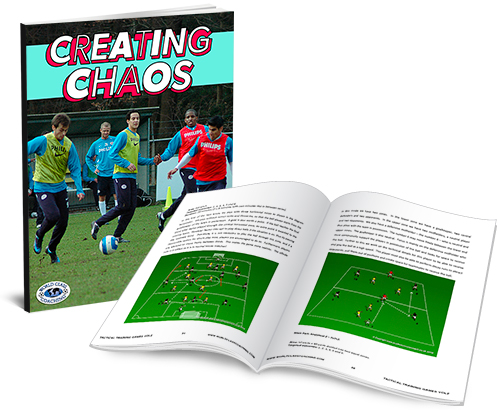
Table of Contents
PART ONE
Introduction
Chaos Practice Elements
Chaos Rondos
PART TWO
Chaos to Recreate Shooting Scenarios
PART THREE
Chaos to Build the Press/Break the Press/Transition
PART FOUR
Chaos to Create Mental Awareness
Conclusion
Introduction
Soccer is a sport that is dependent on such minute variables that hitting the post is seen as unlucky or even, in games with less on the line, nearly as good as a goal. This is a phenomenon that American Football kickers do not enjoy, as evidenced by the 2018 playoffs. To score a goal players must execute their technique to near perfection while avoiding any one of the other 19 field players, the goalkeeper, and keep the ball under the bar.
Players can, and need to, practice their form in order to execute it at a moment's notice but the situations they will see in the game are so incredibly varied that players can never really recreate accurately the pressure, setting, angle, sights, and mental state they will be in during a shot on target. Nor will the placement of the other players, the positioning of the goalie, or the noise from the staff and fans ever be the same. This reality extends beyond shooting, to every single aspect of the game as well. That is why it is my firm belief that to truly prepare players for a game, practice needs to have varying elements of chaos sewn into it as much as possible.
Chaos is defined as “complete disorder and confusion” and at times soccer can embody this definition. Compared to football and baseball, with their clear stop and starts and choreography, soccer is chaotic. It is a mess of 22 bodies in near constant movement adjusting to the random bounce of an inflated ball. A ball is punted 30 feet into the air and players, being jostled by an opposing player, in the air, must correctly strike the ball within a millimeter of accuracy to propel that ball forward. A millimeter to the left and it lands at the opposing striker’s feet, a millimeter back and it jumps over the player’s own keeper.
Positions, other than goalie, have no specific set of rules like in American Football. The left back may score the winning goal, and vice versa the striker may make a goal line clearance. The right midfielder may end up marking a player all the way on the left side of the field. The false nine is now common practice, but now the “false two” is coming into vogue with an outside back playing as a central midfielder in attack and back in defense. There is no way to effectively prepare for every situation your players may face, but by introducing chaos into practice players will be at least willing to adapt to it.
You will see professional coaches blame the referee, grounds crew, medical staff, heat, cold, an unfair red card, a blown call, VAR, lack of VAR, type of ball used, fixture congestion, lack of competitive games, the sun, the floodlights, injuries, wind, and any other myriad of problems that made it impossible for their team to succeed. These are variables they cannot change, and if they cannot change them then the loss cannot be their fault, right? Wrong- their players, if the coach is to be believed, failed to adjust to the problem presented to them.
Implementing chaos into practice can come in many forms and it can improve players in equally as many ways. Some of these advantages include:
● Improve visual scanning and awareness
● Ability to adjust to various scenarios
● Make players mentally flexible (go with the flow and still perform)
● Improve positional awareness
● Create more consistent players
● Make every practice interesting
Chaos Practice Elements
While there are specific drills that will be discussed in this book, attempting to recreate the chaos found in different situations in the game, there are different, simple practice methods that can be implemented on a daily basis to make players more mentally flexible.
Bad Calls: Referees have an incredibly difficult job, and respect for them should be taught to every level of player, but they make mistakes. Most of these are innocent mistakes, but occasionally you will be assigned a referee who took the job for the wrong reasons. It could be they want to show their power and verbally berate your players, or they have some connection to your opposition, or worse your fans have said something to him/her and you won’t be getting a call your way for the rest of the game. These incidents may be rare, since most referees just want to call a straight game, and you may want to call the assigner afterwards, but in the heat of the moment you and your players cannot control the situation and therefore you need to be prepared. To do this in practice my staff and I will select a player/team/or particular part of the game to focus on when we are reffing a game in practice.
We may allow a ball to roll two feet out of bounds and not make the call; initially the defending team will stop playing and the attacking team will take advantage of it by going on the attack. At this point we usually have to address “palms up” behavior and give the “play to the whistle” talk. We have one particular referee who tends to make remarks to players and is very demonstrative if a player shows any sign of dissent. When we know that he is going to be reffing a game we try to recreate those situations in practice as much as possible. We find that our players are then able to better control their emotions in the heat of the moment no matter the referee or situation.
PK Pressure Situations: We call this situation the “three whistle” drill. At any point in practice if the players hear three quick whistles they all know to immediately jog to the endline, this could be done during transitions between activities, at the end of a water break, or even in the middle of a particular activity. We then choose, or allow a player to volunteer, to step up to take a PK.
If they miss, the whole team will need to do some sort of conditioning/lose out on a privilege/etc. so there is pressure on the kick taker to sink their shot. If they miss, it is important to that every player come up to them, give them a high five/hug/pat on the back and reassure them. What this does is remind the player that no matter what happens their teammates have their back and this will give them a mental boost the next time they are in a pressure situation. If they make the shot every player must celebrate with that kick taker and it is a massive boost for team spirit and the individual who scored.
Various Ball Sizes: This is especially effective during indoor practices, but can be used outdoor as well. Replacing the normal practice ball provides some chaos within the game as players are forced to readjust to a new and constantly changing variable. They are forced to truly focus on their touch and the weight of their passes, the more change the more they have to focus, while still dealing with the endless variables the game itself provides.
A drop from size 5 to 3 is the most common change, but coaches can get creative with this. The most effective way to do this is to have a coach with a pile of various balls stand on the touch line and throw/punt new balls in whenever there is a reset. The size/quality/and amount of air in the ball can be varied, in addition kickballs, reaction balls, basketballs, or even a football can be utilized. The key is to keep players off balance and more ready to react to changes in the game at a moment’s notice.
Using Music to Recreate Tempo: It is no secret that if you want players enjoy practice more you can play music for them. Players love it, but stopping and starting the music to yell out key points to your players and dealing with inappropriate music can be a headache for coaching staffs. With that you will have to find a balance, or whether you allow it at all.
The reason they love it is the music makes the situation feel like the movies, it ups the tempo to any drill, but during a game there is no music, and the game is very rarely 80 minutes of high tempo adrenaline. The game has peaks and valleys, and your players must be able to operate mentally, tactically, and technically during every phase of the game. To recreate the tempo drops try playing hardcore fast music, then following it up with a slow song. We prefer blasting some hard rock, then throwing “Cheeseburger in Paradise” on the speaker.
You will initially see that players’ intensity increases during the faster music, but then will drop during the slower songs. With time and practice players will be able to control their emotion and maintain their level of play no matter the song. This will then translate to the game, and players that are able to deal appropriately with the ebbs and flow of the tempo of the game. In addition, pumping in crowd noise during pressure PK situations always adds a sense of realism to the experience.
Socks/Tape for Dominant Foot: This is a strategy used by a number of Brazilian academies to train young players to be dual-footed. The coach provides each player with either a sock or a piece of tape that denotes their strong foot. The defense then knows immediately to attack that foot to force them weak side. In the academies players are forced to wear the socks until the coaching staff deems that they are adequately dual footed, there is even a small ceremony for the player in question.
This is a sound long term strategy, but it can also be used sparingly to create chaos situations where players are allowed to play their regular game the practice or previous drill, and then all the sudden having defenders lunging at their strong side. This is another example of presenting players with a series of challenges that they must overcome while forcing them to improve technically.
Removing Key Players: Injuries and cards are part of the game. There are countless stories of a team losing a key player and their season falling to pieces. While it can be devastating, being prepared for this type of situation can better help your players overcome the challenge when the time comes (this can also help with teams who become far too dependent on one or two players).
The coaching staff should select 1-4 players that have some significance to the team (a strike pairing, the captains, the back four) and have an assistant coach run a separate technical practice for the players in question. The team then runs the activity, or the whole practice, without those key players. The team then learns to play with that player’s replacement, the replacement gets valuable first team reps, and players are forced to find ways to win without those players. Even if the team never has to play without the key players in a game situation they will be more confident in finding a Plan B if the key player is marked out or having an off day.
Headbands: Every coach would agree, players need to scan the field more. Too many times players make a mistake that could have been easily vetoed had they turned their head only inches one way or the other. This idea works best when players have matching training kits, but works equally as well if players simply all wear the same color pinny. Players wear headbands, strings, hats, or just tie pinnies around their heads. This creates a chaotic situation where everyone wearing matching colors, this then forces players to pick their heads up and read visual cues that they cannot recognize with their heads down.
Chaos Rondos
Although it is an often overused adage, Johan Cruyff’s thoughts on the rondo, “Everything that goes on in a match, except shooting, you can do in a rondo,” have stood the test of time. The rondo itself is form of chaos with the high intensity passing, short range, and limited decision making time, therefore they are a perfect tool to add some chaos to your session. There really is endless options of ways to modify and adapt the rondo to your team’s needs but here is a few activities and their various uses.
Name: Two Team Rondo
Description:
The two team rondo is an activity designed to improve player’s vision and mental conditioning by creating a series of distractions that increase as the activity proceeds, but still requires all the base technical elements to be executed to procision throughout
Setup:
Set up a normal rondo with every alternating player wearing a different colored bib. Give a ball to a player with one color big, and one to the other.
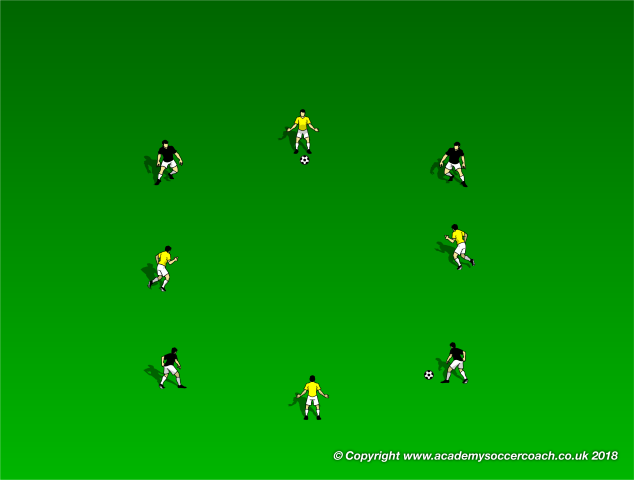
Execution:
Begin the game as a normal rondo with the stipulation that the players cannot pass to the player on their team directly to the left and right of them, and must play either one or two touch. If the balls that are in play touch both teams need to do some sort of conditioning (push ups, sit ups, jumping jacks, etc.)
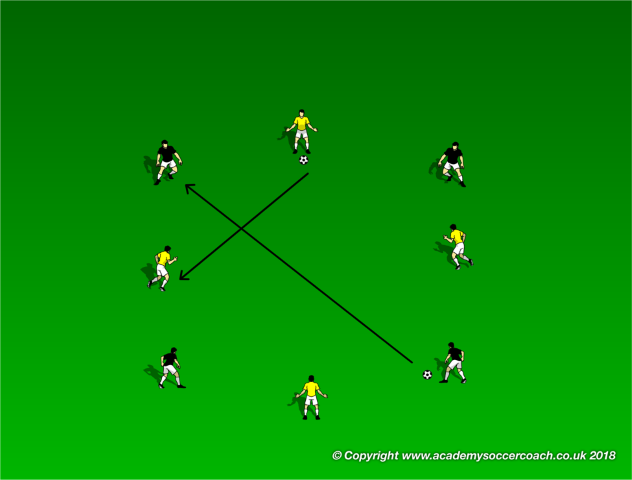
As the drill progresses and the players become more comfortable with the rhythm and technique add a player from each team in the middle. If the player in the middle wins the ball they should pass to their own team so that the team that won the ball now is possessing with two balls. Players on the outside of the rondo can only win possession of a ball if the ball is passed directly to them by the opposition.
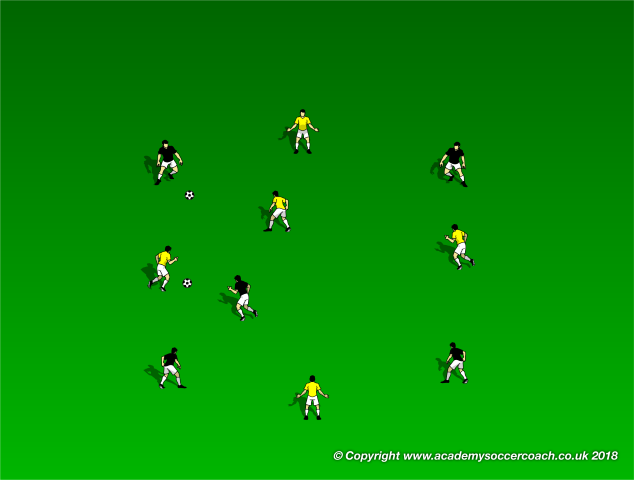
Variations:
To increase the hectic nature of the drill additional balls can be added, for example each team plays with two balls.
To create additional distractions a small tennis ball can be added that players must throw to each other. If the player with the ball receives a pass while holding the ball, or the ball is dropped or held for longer than three seconds the group as a whole must do some sort of conditioning
Rondo Death Star
Description:
This multi-ball rondo forces players to scan the field to recognize passing opportunities and stimuli from multiple angles. The use of the middle coaching stick grid alleviates the problem of players figuring out a pattern and leads to increasing randomness and creativity.
Setup:
A rondo circle is set up with coaching sticks set up in a plus sign with a single stick in the middle. Depending on the number of players there should be 1-5 balls.
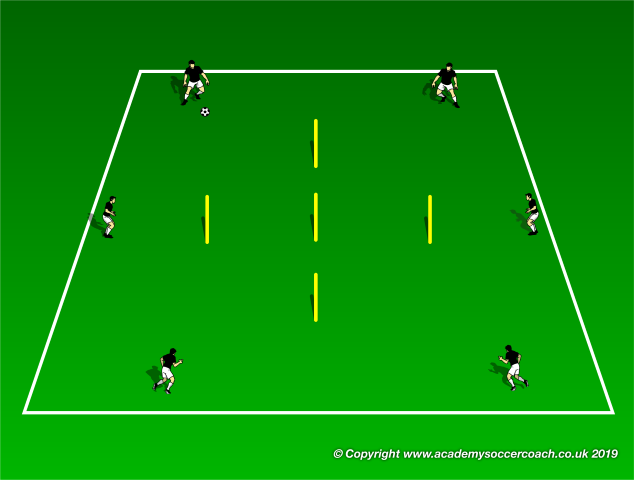
Execution:
Start the session with one ball and the team in the rondo shape. The ball must be passed two touch through at least two of the coaching sticks. The ball cannot go back through the same two sticks that it just went through. Play stops if a ball touches a coaching stick, a player uses more than two touches, two balls touch, a ball goes beyond the rondo line, a player receives more than one ball, or a ball goes back through the same two coaching sticks. Once play stops, players must do some designated fitness, and then repeat.
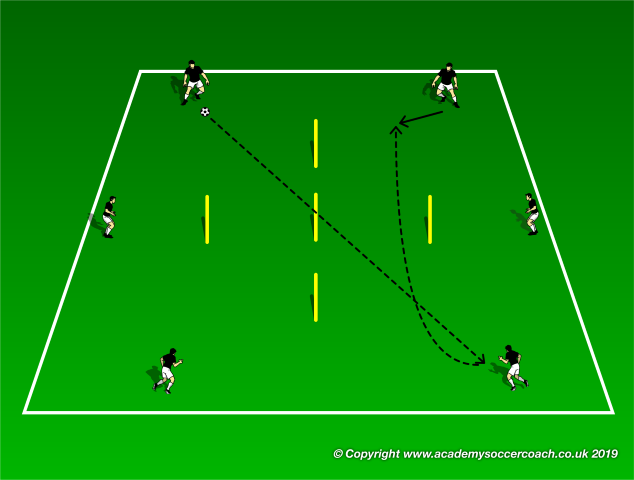
As the players become accustomed to the patterns the coach then adds balls into play as players able to handle.
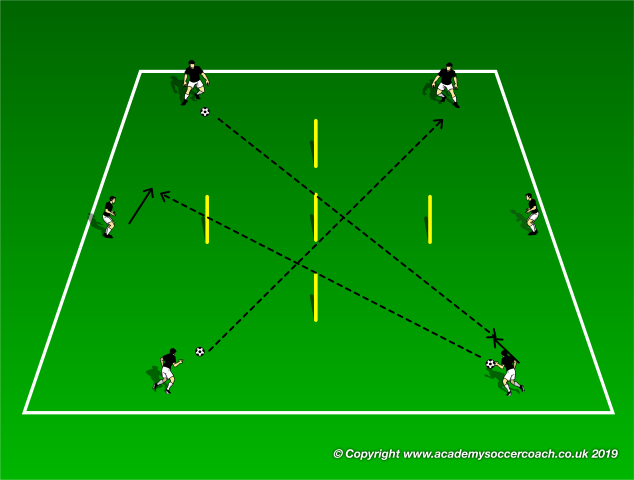
Variations:
A tennis ball can be added to the outside. Players must toss the ball around and play stops if the ball drops or a player with the ball receives a pass.
Rondo Progression
Description:
The Rondo Progression is really more of a series of rondos and activities, and is really only limited to the coaches imagination. The point of the activity is to provide as many stimuli to the players as possible and attempt to bring order to the chaos created by the coach. This drill can be used as a simple warm up to every practice if the challenges can be varied to a noticeable degree.
Setup:
Set up Rondo circle. Balls are placed outside to be quickly replaced. Optional: Have any other types of balls or gear you are going to use on the outside as well.
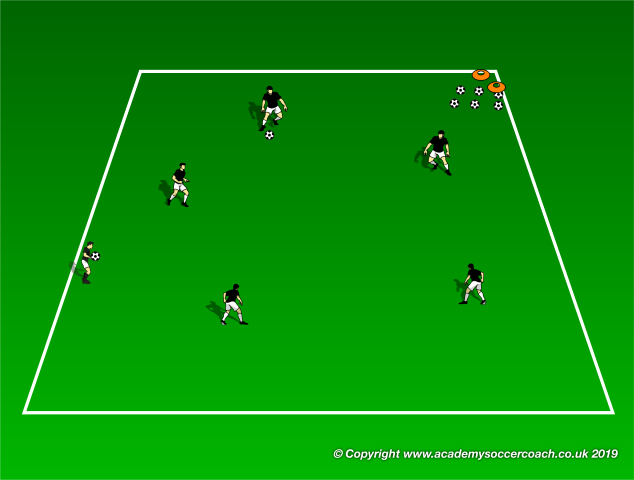
Execution:
Players play a normal unopposed rondo at first. The coach then progresses from there to two balls within the rondo, then add players throwing a ball to each other with the two balls or throwing a tennis ball/cone/frisbee to each other.
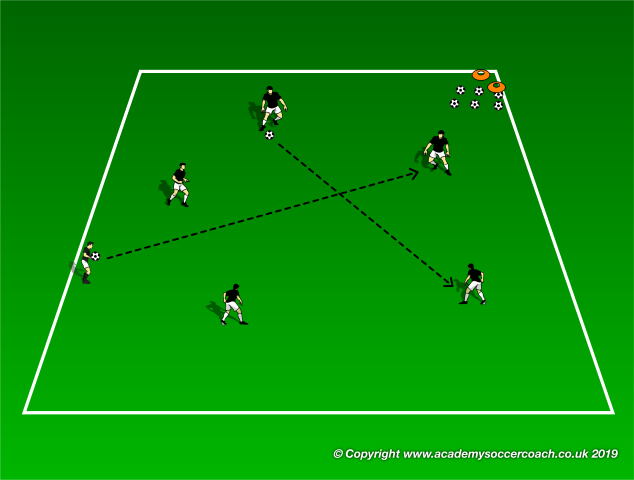
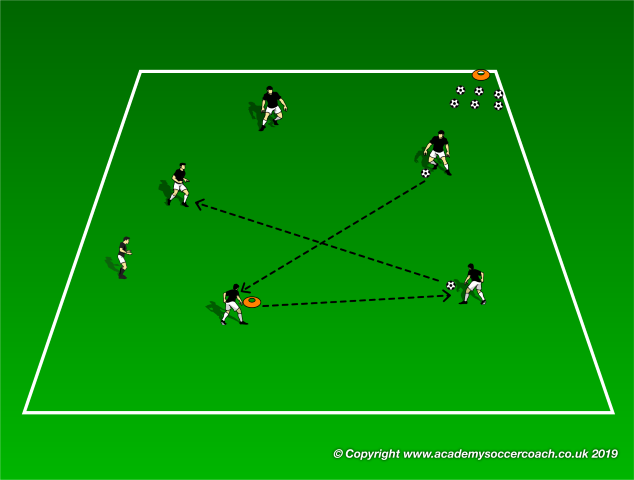
The following rules apply to all progressions: if a ball is played to the player holding a ball the group does some type of brief conditioning work. In addition if any ball comes into contact with another ball, one of the ball drops, or a player is passed two balls at one time, the group conditions.
Variations:
Coaches can get creative here depending on the number of players available and their skill level. As long as the players are being constantly stimulated and forced to make decisions the activity is effective.
Breakout Rondo
Description:
The Purpose of the Breakout Rondo is to recreate the chaos inherent in transition. Players that are on offense are forced to “flick the switch” to a defensive posture and mindset the moment the ball is lost. Players that have lost the ball must decide whether they should press or drop off to cover their mark, all while finding a body position where they can see both attackers enough that they can make that decision.
Setup:
Players form a rondo circle (5-8 players) with 1 player in the center. For every player on the inside another player stands 5 feet behind them, creating a larger outer circle.
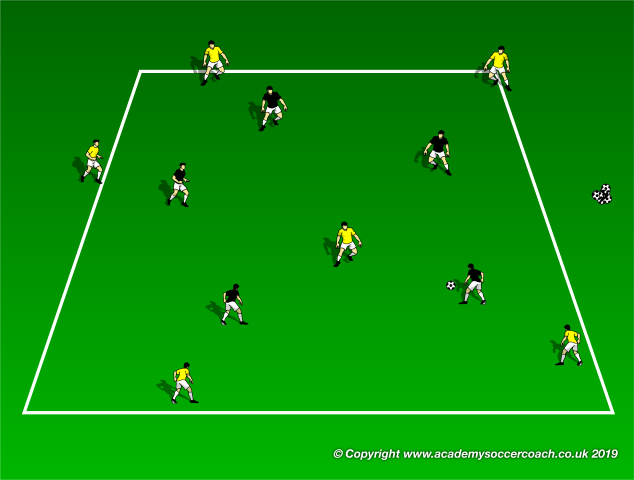
Execution:
The Breakout Rondo activity starts as a regular rondo with the rondo circle players passing among themselves, and the single defensive player in the middle attempting to win the ball back. When the single player is able to retrieve the ball their goal is to pass to one of their teammates on the outer circle.
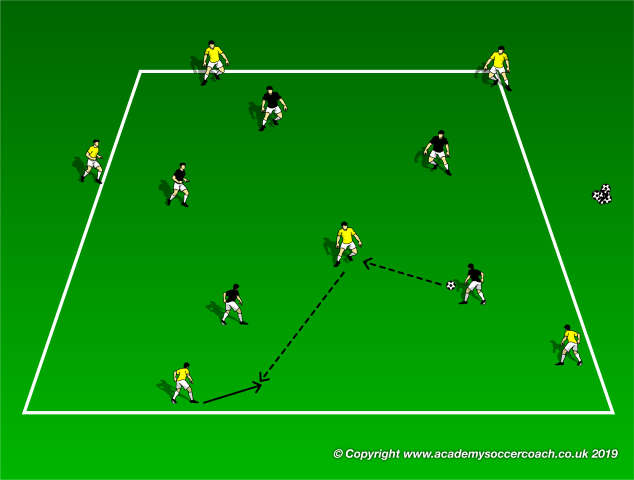
If they complete their pass to the outer circle player, the player in the inner circle that was in front of the outer circle player is now in the middle of the rondo, the passer moves to the outer circle, and the outer circle moves into the inner circle.
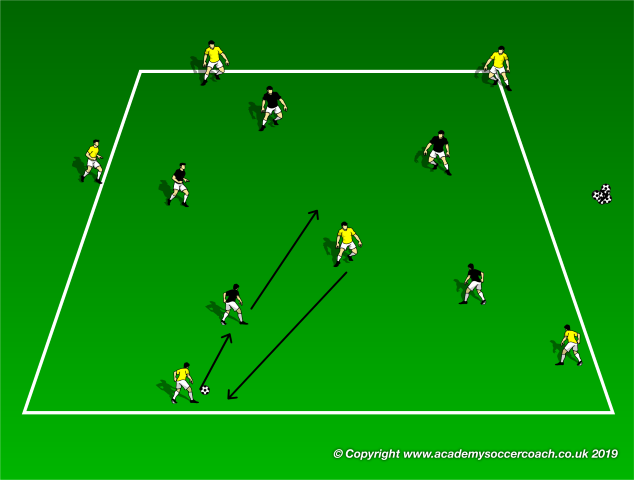
In doing so the defender in the middle must quickly transition from a defensive player to an offensive player seeking a pass to breakout out of the press. The inner circle players transition from offensive to a defensive posture blocking passing lanes and opening their bodies up to get in position to check their shoulders to see both the ball and their assigned outer circle player. The outer circle players must transition from a defensive cover position to an offensive posture where they will need to receive a pass that breaks the inner circles lines.
Variations:
Variations can be made to the number of players in the middle so that the players in the center of the rondo collaborate in breaking the press.
To add complexity to the two player variation additional passing patterns can be added such as the outer circle player who received the pass must then play to another outer circle player, and then both players involved go into the inner circle, both inner circle players go to the center of the rondo, and both defenders go to the outer circle.
Hurt Locker
Setup:
Set up four lines about 10 yards apart in a diamond. Give one ball to each of the intersecting lines, and one to one of the players at the end of a line.
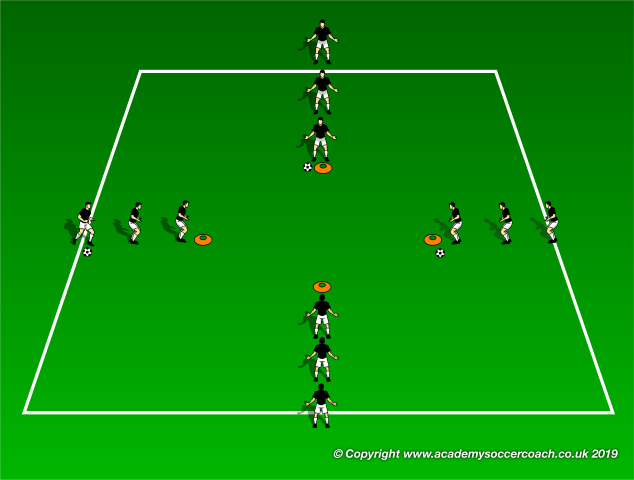
Execution:
Players must pass to the player in the other line directly facing them. Once the first pass is made every pass must be one touch and the ball cannot stop moving. The passer must follow his pass and go to the end of the other line. The balls from either line cannot touch. While the intersecting passes are happening on the inside, a ball is being played around the outside. The last player in line should check out to receive a pass, receive on their back foot, and play two touch to the last player in the next line.
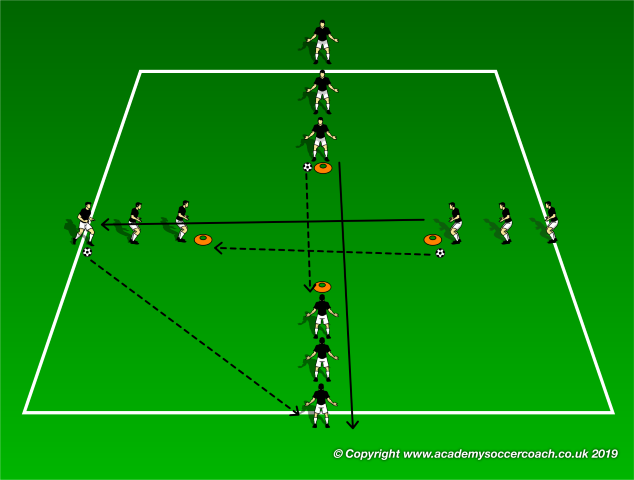
At any point if the balls in between the lines stop, touch, hit a player, or is played with more than one touch the activity resets. Players should look to continue the pattern for a total of 3 minutes.
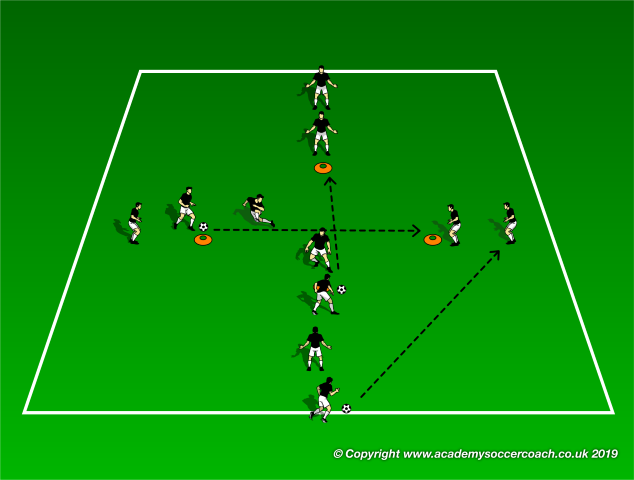
Variations:
Additional lines can be added
The time to complete can change or it can be changed to a number of passes needed to complete.
Fitness can be added in between each reset.


